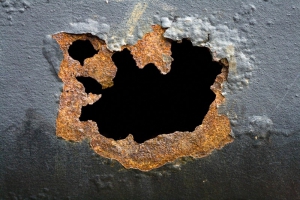Corrosion management crucial to pipeline integrity
Corrosion management is a vital focus of the oil and gas industry as it pertains to safeguarding valuable assets and securing the proper processing and transportation of the nation’s natural resources. Pipeline operators in particular have millions of miles of distribution networks to protect and manage in real time to maintain operational efficiency. Corrosion at any point along these pipelines can create a chemical chain reaction, putting pipelines at risk of leaks or failure.
Today’s oil and gas pipeline companies are equipped with the latest technologies and services to mitigate corrosion issues. In addition, pipeline integrity is no longer a matter of reactive solutions as operators view integrity through a proactive lens.
Identifying causes and types of corrosion
While a multitude of pipelines remain under construction or in the permit approval process, fully operational pipelines are in many cases decades old. Over time, the possibility of corrosion setting in rises, yet companies are more capable than ever at understanding and locating the causes of corrosion.
“There is now a greater emphasis on services that are noninvasive and more efficient.”
The International Journal of Industrial Chemistry indicated corrosion in the oil and gas industry most commonly forms as a result of aqueous agents contacting steel. With carbon dioxide and hydrogen sulfide present, water serves as a catalyst for corrosion, thus causing rust. If left unattended, pipelines can develop and succumb to a number of different types of corrosion.
Common forms of corrosion, according to IJIC are:
- Oxygen corrosion – oxygen reacts with exposed metal
- Sweet corrosion – carbon dioxide mixes with water to become acidic
- Sour corrosion – hydrogen sulfide dissolves in water and embrittles metals
- Crevice corrosion – stagnant fluid buildup in crevices
- Galvanic corrosion – electrons turns one of two contacting metals into a corrosion anode
- Microbial corrosion – organic acids increase fluid toxicity
- Erosion corrosion – constantly removes layer of pipeline walls
- Stress corrosion cracking – metals crack under intense corrosive stress
These corrosion types are the underlying factors affecting pipelines that operators and service providers work to prevent on a daily basis. Rather than simply react to onsetting corrosion, oil and gas companies also employ the use of protective coatings to inhibit the formation or spread of corrosive elements.
Corrosion protection
The Pipeline and Hazardous Materials Safety Administration noted operators break down corrosion into external and internal categories. To assist in corrosion protection, companies apply coatings along the exterior of the pipeline. These coatings inherently contain a hydrophobic quality, which deters water accumulation and provides an immediate barrier between the metal pipe and potentially harmful liquids. Relying on the most-advanced compounds of epoxies, polyurethanes and acrylics, among others, operators coat pipelines as much as possible.
However, in some cases, it’s also necessary to utilize a method of cathode protection. This technique sends a direct current along the pipe in areas where the coating is missing, essentially acting as a stopgap measure in preventing fluids from damaging the metal.
Internal corrosion prevention techniques also use coatings in addition to liners and traps that capture contaminants, PHMSA stated. In most gas pipelines, dehydration is used because excess liquids moving through pipelines can be especially corrosive. By drying out the gas, prior to transport, pipelines are less susceptible to pooling of water, acids and chemicals.
Critical assessment of pipelines
Recent advancements in non-destructive testing have enabled operators to gather the information they need to prevent corrosion and other environment-intensive issues before they start. Because portions of pipelines must be taken out of operation for traditional methods of corrosion protection to be employed, there is now a greater emphasis on services that are noninvasive and more efficient.
Large-scale operators take a more calculated, holistic approach to assessing the integrity of their pipelines. Laser inspection tools, ultrasonic testing and risk-based inspections provide the backbone of critical safety assessments, allowing companies to identify where problems are likely to occur and how to overcome them. Not only does this approach reduce the risk of failures and unplanned shutdowns, but it also provides comprehensive data on the status and condition of existing pipelines.
With this vital information, corrosion can be prevented and working pipeline safety solutions can be incorporated into future operations.
